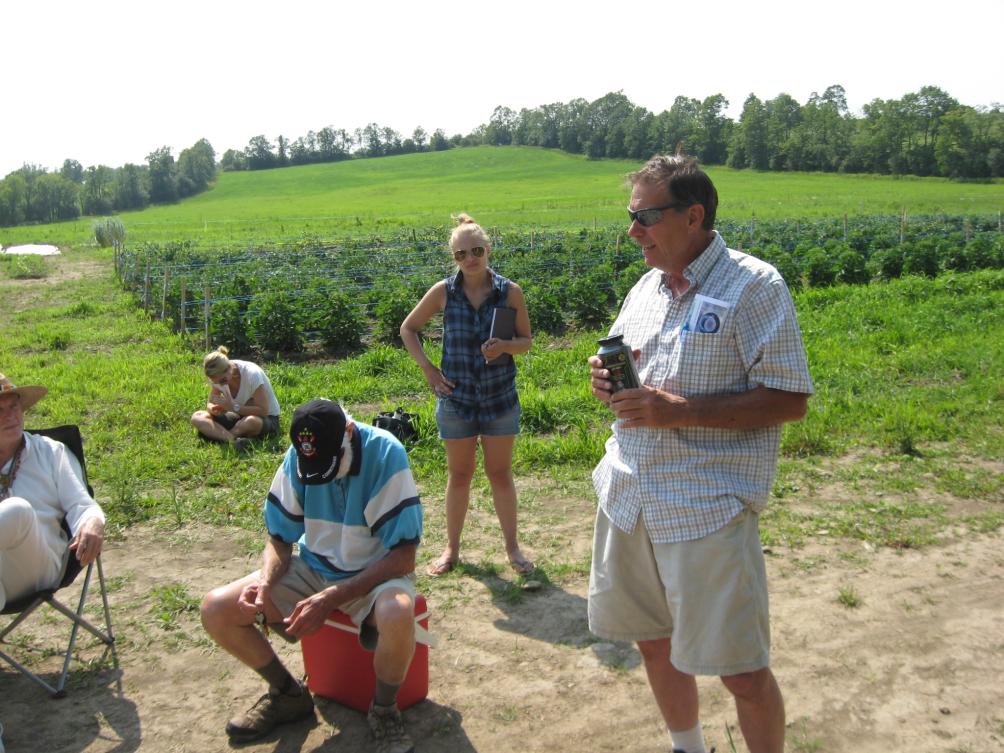A joint CSAYN – Biochar Ontario event
When: Saturday July 11, 2015 (1pm – 4 pm)
Where: Trent University, Field Experimental Station
Peterborough, Ontario http://www.trentu.ca/
Who: Biochar Ontario & CSAYN-Canada
A summary of the demonstrations at the Trent University Farm
After LUNCH we performed a Live Biochar Production Demonstration at the Trent University Farm, starting with:
o Lloyd Helferty (MC), Introductions [~5min]

Lloyd opened up the day by introducing Biochar Ontario and CSAYN-Canada, and also providing an overview of the concept of “Climate Smart Agriculture” and how Biochar fits into the overall concept of Climate Smart Farming and Food production systems.
o Mitch Gold, Opening Ceremony [~10min]
Mitch did our Opening Ceremonies by telling everyone the story of the Eagle and the Condor and then blowing the conch shell in the Four Directions, North, East, South, and West.
o Prof. Dr. Raul Ponce-Hernandez, D. Phil., Environmental Program, Trent University [~15min]
Raul gas us an introduction to:
the Trent U “Sustainable/Climate Smart Ag and Food Systems Program”
the Sustainable Agriculture Field Experimental Station [Trent U. Farm]
Raul provided us with an excellent overview of the Trent University Farm and the programs that both the professors and the students are involved in. His take home message:
“We need to get some concrete outputs. The younger generation wants real action; to put something concrete on the ground.”
o Harry Ha, Small stove demo & talk on integrated bio-energy / district energy [~30min+]
Harry gave an excellent demonstration of his char-producing “stove”, and even cooked a “meal” of instant noodles for us to sample. His stove was a new design based on the Top-Lit-Up-Draft (TLUD) principles, but with a “hybrid” design that included both an inner and outer ring of biomass.
A Data logger was connected to Harry’s stove during his demonstration, provided courtesy of Julien Winter, so that we could obtain values for the heat / energy that is produced by the stove during the burn. The maximum
temperature of the burn was almost 700 degrees Celsius.

Harry’s stove design resulted in the production of biochar in the inner chamber only, while the outer chamber burned to ashes. His biochar is expected to be very high pH with high ash content.

After the biochar was “washed” (the ash rinsed away), the biochar looks very nice. The ash can still be seen clinging to the char, which indicates that this biochar should be suitable for acidic soils, which is typical in tropical countries like Haiti, where Harry has also been doing some experiments with biochar and humanure composters.

Harry then explained for us his concepts for the creation of a Combined Heat and Biochar (CHAB) system that could be designed to produce “District Energy” in the form of Heat and possibly also Electricity, as well as biochar.

o Julien Winter, Large system Demo [~30min+]

Julien explained to us his more traditional TLUD design using large barrels, and all of the many scientific experiments that he has done to measure their performance.
Julien then performed a demonstration of char-making using a TLUD and vertically-oriented wood sticks.
Julien also explained the operation of this much larger 55 gallon TLUD design, with afterburner, to the delight of all the audience members, who unfortunately could not see it in operation since the burn time would have been too long and we were running out of time. He did show us the very clean biochar that resulted from his burn using the smaller TLUD and the vertical wood sticks.

Julien delighted the audience members with his talk.
o Don Trott, Words of advice for farmers [~10min]

Don then gave us his own advice and experience as a farmer in the Ottawa Greenbelt who has been dabbling with biochar for the past several years.
o Lloyd Helferty, Inoculation talk [~20min+]
Lloyd then gave a brief, and slightly controversial, talk about the “optimum” methods of preparing biochar for use in soils. This led to an exchange between Dr. Ponce-Hernandez and himself regarding the “proper” way to prepare and utilize biochar for maximum benefit in Canadian soils. Biochar is obviously a new science!

We then wrapped up the day with a final photo shoot for the young farmers in attendance at our event.
Along with a final “offering” to the “Soil Gods”…














